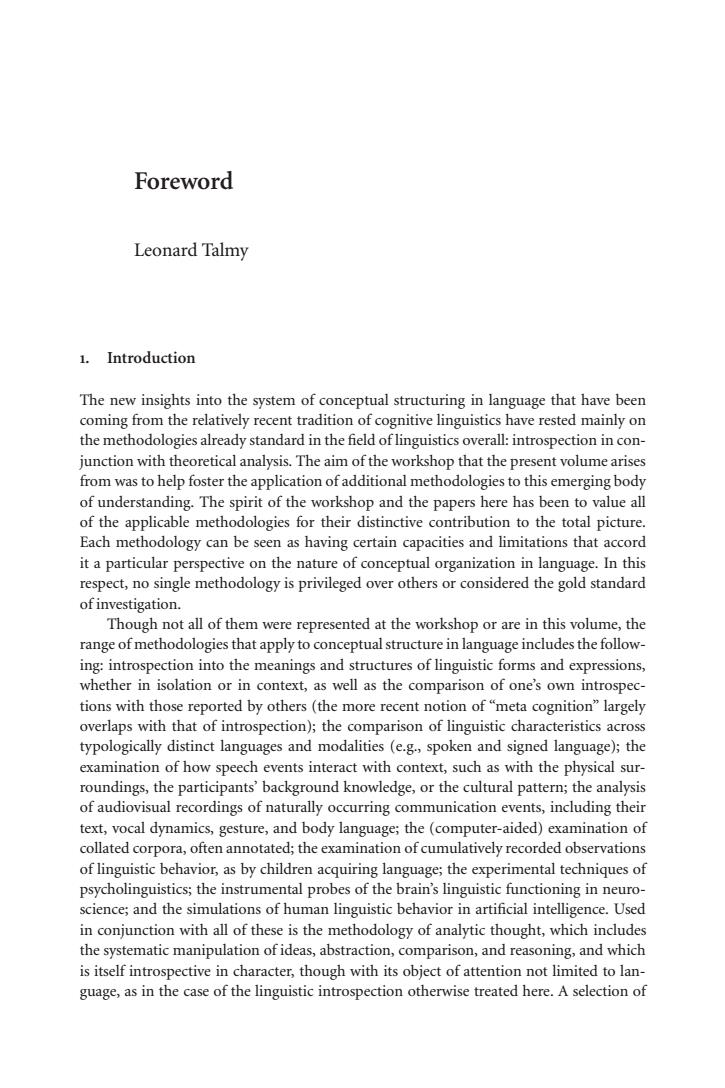正在加载图片...

Foreword Leonard Talmy 1.Introduction The new insights into the system of conceptual structuring in language that have been coming from the relatively recent tradition of cognitive linguistics have rested mainly on the methodologies already standard in the field of linguistics overall:introspection in con- junction with theoretical analysis.The aim of the workshop that the present volume arises from was to help foster the application of additional methodologies to this emerging body of understanding.The spirit of the workshop and the papers here has been to value all of the applicable methodologies for their distinctive contribution to the total picture. Each methodology can be seen as having certain capacities and limitations that accord it a particular perspective on the nature of conceptual organization in language.In this respect,no single methodology is privileged over others or considered the gold standard of investigation. Though not all of them were represented at the workshop or are in this volume,the range of methodologies that apply to conceptual structure in language includes the follow- ing:introspection into the meanings and structures of linguistic forms and expressions, whether in isolation or in context,as well as the comparison of one's own introspec- tions with those reported by others (the more recent notion of "meta cognition"largely overlaps with that of introspection);the comparison of linguistic characteristics across typologically distinct languages and modalities (e.g.,spoken and signed language);the examination of how speech events interact with context,such as with the physical sur- roundings,the participants'background knowledge,or the cultural pattern;the analysis of audiovisual recordings of naturally occurring communication events,including their text,vocal dynamics,gesture,and body language;the(computer-aided)examination of collated corpora,often annotated;the examination of cumulatively recorded observations of linguistic behavior,as by children acquiring language;the experimental techniques of psycholinguistics;the instrumental probes of the brain's linguistic functioning in neuro- science;and the simulations of human linguistic behavior in artificial intelligence.Used in conjunction with all of these is the methodology of analytic thought,which includes the systematic manipulation of ideas,abstraction,comparison,and reasoning,and which is itself introspective in character,though with its object of attention not limited to lan- guage,as in the case of the linguistic introspection otherwise treated here.A selection ofJB[v.20020404] Prn:12/04/2007; 9:50 F: HCP18FR.tex / p.1 (47-114) Foreword Leonard Talmy . Introduction The new insights into the system of conceptual structuring in language that have been coming from the relatively recent tradition of cognitive linguistics have rested mainly on the methodologies already standard in the field of linguistics overall: introspection in conjunction with theoretical analysis. The aim of the workshop that the present volume arises from was to help foster the application of additional methodologies to this emerging body of understanding. The spirit of the workshop and the papers here has been to value all of the applicable methodologies for their distinctive contribution to the total picture. Each methodology can be seen as having certain capacities and limitations that accord it a particular perspective on the nature of conceptual organization in language. In this respect, no single methodology is privileged over others or considered the gold standard of investigation. Though not all of them were represented at the workshop or are in this volume, the range of methodologies that apply to conceptual structure in language includes the following: introspection into the meanings and structures of linguistic forms and expressions, whether in isolation or in context, as well as the comparison of one’s own introspections with those reported by others (the more recent notion of “meta cognition” largely overlaps with that of introspection); the comparison of linguistic characteristics across typologically distinct languages and modalities (e.g., spoken and signed language); the examination of how speech events interact with context, such as with the physical surroundings, the participants’ background knowledge, or the cultural pattern; the analysis of audiovisual recordings of naturally occurring communication events, including their text, vocal dynamics, gesture, and body language; the (computer-aided) examination of collated corpora, often annotated; the examination of cumulatively recorded observations of linguistic behavior, as by children acquiring language; the experimental techniques of psycholinguistics; the instrumental probes of the brain’s linguistic functioning in neuroscience; and the simulations of human linguistic behavior in artificial intelligence. Used in conjunction with all of these is the methodology of analytic thought, which includes the systematic manipulation of ideas, abstraction, comparison, and reasoning, and which is itself introspective in character, though with its object of attention not limited to language, as in the case of the linguistic introspection otherwise treated here. A selection of